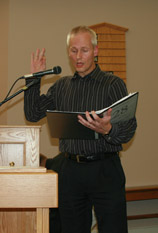The Organist
The Training of an Organist
In order to play in the worship service, an organist needs to be trained in three fields: as an accompanist, as a soloist and as a leader.
Accompanist
An organist is trained to be an accompanist. This involves an empathy with a solo or congregation, for the accompanist is trained to follow. The organist shifts into this mode when accompanying a congregation, choir and following a director, or when accompanying a soloist. If a congregation pulls tempo, a soloist skips a phrase, or does anything else, the accompanist must follow, and must play softer than the voices are singing. In a situation where the organist is trained and the singers or soloists are not, this can provide some challenges.
Soloist
As a soloist, the organist is free to interpret. Preludes, postludes, and pieces during the offertory or collection: these are individual, solo pieces. While the organ is a difficult instrument -- not for the timid -- there are many fine pieces by well-known composers that can be played successfully by beginning organists. Composers have given us no end of suitable pieces for this instrument, pieces that are sacred in nature, pieces that can draw us to meditation, and thus, to God.
Leader
The third part of organist training is as leader. Here the organist is trained to set the tempo, give the breaths, etc. By strong, authoritative playing, the organist will pull the congregation along -- and the average singer in the pew is less likely to be intimidated by sound of his own voice, hence more likely to sing out.
A good organist knows that the introduction to a psalm or hymn should sound like the psalm or hymn, not a creative improvisation that has nothing to do with what the people will sing. The introduction -- sometimes an entire verse -- must be played in the same tempo in which the people are to sing. This cues the congregation: "Here is the music you are going to sing, and this is how fast you will sing it".
The organist as leader will determine breathing points, and will signal this by lifting his hands very briefly from the keyboard at the end of phrases, while keeping the tempo. This helps to keep everyone together.
The better the training, the louder one plays
There is an old saw about organists that says: the better the training, the louder one plays! This may come as a shock, even evoke a few complaints, but it is a proven way to get the congregation to sing!
Resources for Aspiring Organists
The church needs an organist, and that organist, if un-trained, needs to find a teacher and take lessons. And all organists can benefit from the support and encouragement of other experts in the field. There is much help available.
The American Guild of Organists (US) or the Canadian College of Organists (CA) is the best place to start. There are local chapters and centres in many areas. Teaching materials and videos are available that instruct on the correct way to lead congregational singing from the organ console. The Organ Historical Society also has many materials available, including fine collections of organ music.